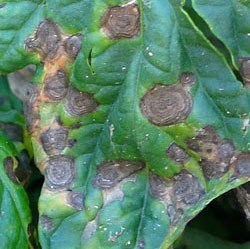
Early Blight of Potato:
Occurrence & importance:
- Occurs in humid and warm areas of world
- Cause losses up to 5-78%
- $45 million is spent on fungicides to control early blight of potato.
Etiology:
Causal organism: Alternaria solani
Order: Moniliales
Family: Dematiaceae
Symptoms:
- On leaves dark brown spots appear surrounded by yellow halo.
- Concentric rings (like target board) develop. These spots resemble with bull’s eye.
- In drought spots turn hard, in humid rotting patches appear
- Stem show brown to black lesions
- In severe attack leaves shriveled, dehisce*(split apart) & fall off.
- On infected tubers sunken*(deepen from normal surface) and irregular lesion appear.
Disease cycle: soil, warm humid, PLB (cool, moist)
- Fungi remain viable in dry infected leaves or debris for a year or more
- Contaminated tubers also primary source of inoculum
- Secondary infection occurs through wind, water & insects that aid fungal spores to move from infected to healthy plants.
Epidemiology:
- 13.6-23.6°C,
- Dew, Infrequent rain & more than 80 % RH favors the fungal growth.
Management:
- Cultural practices: a) crop rotation (b) Sanitation (c) burning of residues
- Spray Zineb, Dithane M-45 0.2%, Blitox-50 0.25% at 10-21 days interval.
- Resistant genotypes i.e. Desiree


